
Stelis, or leach orchids, is a large genus of orchids, with perhaps 500 species. The generic name Stelis is the Greek word for 'mistletoe', referring to the epiphytic habit of these species. These mainly epiphytic plants are widely distributed throughout much of South America, Central America, Mexico, the West Indies and Florida. Stelis is abbreviated Ste. in the horticultural trade.

The orchid genus Dracula, abbreviated as Drac in horticultural trade, consists of 118 species native to Mexico, Central America, Colombia, Ecuador and Peru. The name Dracula literally means "little dragon", an allusion to the mythical Count Dracula, a lead character in numerous vampire novels and films. The name was applied to the orchid because of the blood-red color of several of the species, and the strange aspect of the long spurs of the sepals. The plants were once included in the genus Masdevallia, but became a separate genus in 1978. This genus has been placed in the subtribe Pleurothallidinae.
Restrepia chocoensis is a species in the orchid family (Orchidaceae), named for the Department of Chocó, Colombia, where it was discovered.

Restrepia muscifera, commonly known as the fly-carrying restrepia, is a species of orchid.
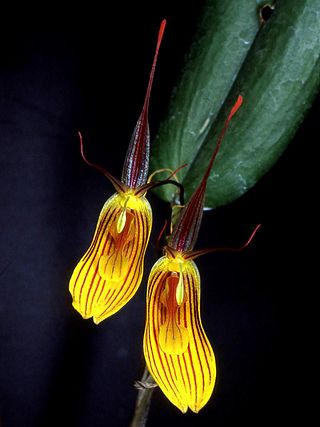
Restrepia falkenbergii, commonly called the Falkenberg's restrepia, is an epiphytic orchid, found at altitudes between 1,000 and 2,000 m in Colombia.

Stanhopea is a genus of the orchid family (Orchidaceae) from Central and South America. The abbreviation used in horticultural trade is Stan. The genus is named for the 4th Earl of Stanhope (1781-1855), president of the Medico-Botanical Society of London (1829-1837). It comprises 55 species and 5 natural hybrids. These epiphytic, but occasionally terrestrial orchids can be found in damp forests from Mexico to Trinidad to NW Argentina. Their ovate pseudobulbs carry from the top one long, plicate, elliptic leaf.

Oncidium, abbreviated as Onc. in the horticultural trade, is a genus that contains about 330 species of orchids from the subtribe Oncidiinae of the orchid family (Orchidaceae). As presently conceived, it is distributed across much of South America, Central America, Mexico and the West Indies, with one species (O. ensatum) extending into Florida. Common names for plants in this genus include dancing-lady orchid and golden shower orchid.
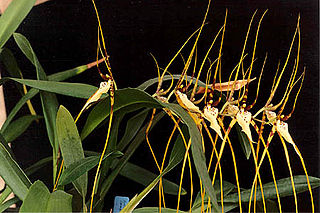
Brassia is a genus of orchids classified in the subtribe Oncidiinae. It is native to Mexico, Central America, the West Indies, and northern South America, with one species extending into Florida.

Scaphosepalum is a genus of plants belonging to the family Orchidaceae. The species in this genus are mostly found in Central and South America, with one species extending into southern Mexico. In accordance with their genus name, many species in this genus produce unusual and distinctive flowers; some possessing cushion-like characteristics reminiscent of an African buffalo's horns, others possessing characteristics of snake fangs.

Porroglossum is a genus of orchids native to the Andes of South America. The center of diversity lies in Ecuador, with many of the species endemic to that country, though others are found in Colombia, Venezuela, Peru, and Bolivia. This genus is abbreviated Prgm in horticultural trade.

Ponthieva is a genus in the orchid family (Orchidaceae), commonly known as the shadow witch. They are named after Henry de Ponthieu, an English merchant of Huguenot ancestry who sent West Indian plant collections to Sir Joseph Banks in 1778.
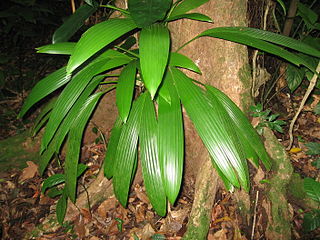
Asplundia is a genus of plants belonging to the family Cyclanthaceae. They are distributed in the Neotropical realm from southern Mexico to southern Brazil.
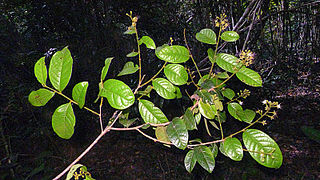
Hirtella is a genus of 110 species of woody trees in family Chrysobalanaceae. It was first described as a genus by Linnaeus in 1753. Hirtella naturally occurs in tropical forests throughout Latin America, the West Indies, southeast Africa, and Madagascar. The flowers are mainly pollinated by butterflies.
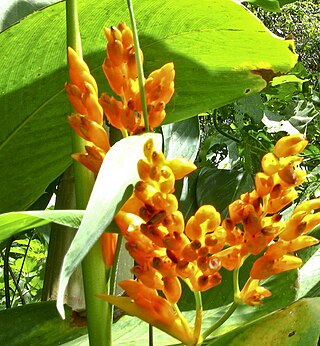
Stromanthe is a genus of flowering plants in the family Marantaceae, native to the tropical portions of the Americas from Mexico to Trinidad to northern Argentina.
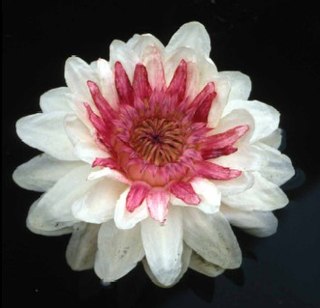
The Flora of Colombia is characterized by over 28,000 species of green plants.
Teagueia is a genus of orchids. They are found at high altitudes in the Andes in Colombia, Peru and Ecuador.
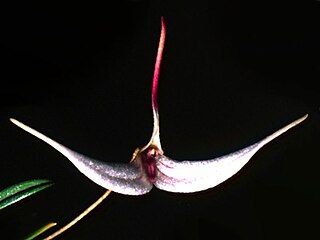
Trisetella is a genus of orchids, native to Central and South America. Twelve of the 23 currently known species are endemic to Ecuador. They bear small flowers with fused sepals and fused petals. The synsepal bears three hair-like tails, which is the namesake of Trisetella.

Restrepia guttulata, commonly called the small-spotted restrepia, is a species of orchid occurring from Venezuela to Ecuador.

Epidendrum coriifolium is a sympodial orchid which grows both terrestrially and epiphytically at altitudes of 1.4—1.7 km in dense forests in Brazil, Ecuador, Mexico, Central America, and Venezuela.









































